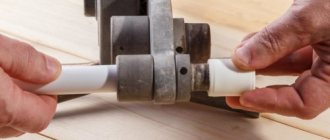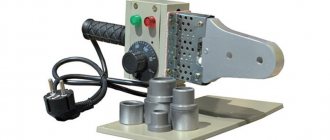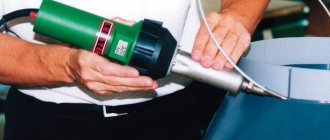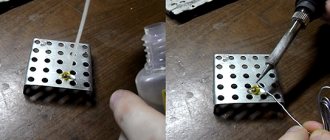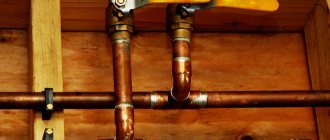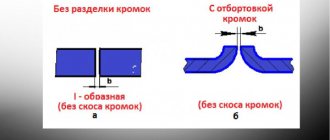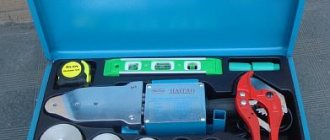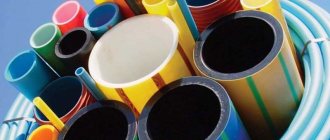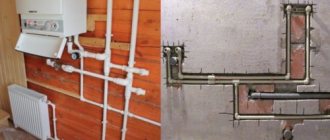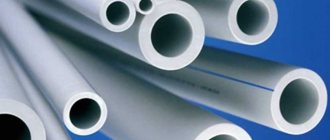Welding of polypropylene pipelines is carried out during the installation of heating systems, sewerage, water supply, as well as during the repair or modernization of an existing pipeline. When joining the elements, a strong connection, tightness and safe operation of the pipeline for a long time are ensured. Soldering of polypropylene pipes is carried out using a soldering iron. The tool is also called a welder or an iron for polypropylene pipes.
Soldering a polypropylene pipe Source besplatka.ua
Soldering technology
When heated, polypropylene becomes soft, resembling plasticine in consistency. Particles of liquid material mutually penetrate into the adjacent part. After cooling, it hardens and becomes resistant to tearing. The cooled seam is not inferior to the base material in technical parameters. To ensure a quality connection, it is recommended to meet the following conditions:
- polypropylene is heated with the device to a state of viscous fluidity, following the instructions in the instructions for the equipment;
- solder products from the same material, you should not connect polypropylene parts with different markings, the strength of the connection will be impaired;
- the ends and fittings are joined tightly, avoiding gaps and distortions; a tight fit is ensured by sanding the cut edge of the pipes with sandpaper;
- polypropylene hardens quickly, leveling is possible within a few seconds, after hardening it will be impossible to correct the defect.
Iron for welding pipes Source nehomesdeaf.org
Thanks to the thermoplastic characteristics of polypropylene, reliable joining of elements is ensured. A strong seam is obtained only if welding technology is followed and quality materials are selected. Let's look at how to solder polypropylene pipes below. On devices that support the installation of several nozzles, the sleeve can be installed in a convenient position. The location of the heating cartridge does not affect the quality of heating.
Other methods for soldering PP pipes
In addition to classical soldering, several additional connection options are known. They all differ in their characteristic features. Each method has both positive and negative sides. Let's get to know them in more detail.
Application of electrical fittings
The installation of such a pipeline is simplified if you use couplings that are equipped with special heating coils.
The welding machine is connected to the contacts coming out of the coupling. Voltage is applied to them and maintained for a certain time.
How to use
- the surface is thoroughly cleaned, then degreased;
- the pipe is inserted into the connecting element and tightly fixed;
- the welding machine is connected to the electrical contacts of the electrical fitting;
- after turning on the device, it will be possible to observe through special holes in the fitting how the volume of plastic melts and increases; the device will turn off automatically; the welding time is regulated by the device itself, which takes into account the ambient temperature;
- the tool is disconnected from the contacts.
The main advantage of this method is its speed.
Soldering takes a second, and cooling lasts one minute. You can forget about hard-to-reach areas. The fact is that the soldering itself is performed on a specific place of previously assembled parts. This is very convenient when you need to install a closed heating system. Such work can be carried out even in mild frosts, but the temperature should not be lower than -15 °C. At lower values, it is prohibited to use a soldering iron. The use of electrical fittings allows construction companies to speed up work on large sites.
The private sector rarely uses this method, since the cost of this equipment is very high. The price of an electrofusion device is in the range of 80-100 thousand rubles.
Cold welding
To use this technique, you must have a special glue designed to soften the top layer of the product. This is one of the ways to connect polypropylene pipes without a soldering iron.
How to use
- parts are adjusted;
- a suitable set of fittings is purchased;
- the surfaces to be joined are well degreased;
- a layer of glue is applied to each plane;
- the inserted parts are tightly fixed for 20 seconds;
- It is prohibited to move elements within one hour.
As a result, the connection becomes strong and reliable, similar to soldering.
Do not heat glued seams. Cold welding can only be used to install cold water pipes!
Another way to join PP products without a soldering iron is to use a torch. You cannot set the temperature on this device, so you have to do everything by eye.
Difficulty of welding
Test installation and connection of the first link of the system can be performed on a table or on the floor in a convenient place. Further welding on site is carried out under various technical conditions. Some areas of the system are difficult to access with an iron.
Before soldering pipes in hard-to-reach areas, it is recommended to choose a comfortable position. An inconvenient location causes delays in work and the appearance of various defects, for example:
- overheating of parts with melting of polypropylene and its spreading;
- the connection is deeper or smaller than required by the standard;
- installation with bending or rotating the element.
Installation of equipment on the platform Source static.onlinetrade.ru
When heating and connecting, synchronous actions should be observed: both parts are heated and removed from the nozzle at the same time. There is no delay before assembling heated parts. The pause occurs due to the need to place the device on the platform. Technical downtime directly depends on the experience of the technician and his speed of work. Errors in work lead to sagging, seam mixing, cracking and damage to the joint.
Types of reinforcement
Today there are two types of reinforcement:
Each type of reinforcement gives the product certain properties.
Aluminum
Polypropylene pipes reinforced with aluminum consist of several layers, between which aluminum foil is located. The layers are glued together with polypropylene glue.
Note! The quality of multilayer products largely depends on the quality of the adhesive joint. Therefore, it is not uncommon for cheap pipes to delaminate under certain operating conditions.
It must be said that aluminum reinforcement comes in two types:
Fiberglass
Fiberglass is an alternative to aluminum. As in the previous case, there are layers of polypropylene on the outside and inside of the product, and a layer of fiberglass on the inside. Moreover, all layers are monolithic.
The inner layer of these products is welded to the outer and inner. As a result, polypropylene holds the fiberglass fibers together, and the fiberglass, in turn, prevents it from deforming. Unlike the previous type of reinforcement, when using fiberglass, no glue is used.
The disadvantage of fiberglass is that it increases the weight of the product, but its price is slightly reduced. True, the cost largely depends on the manufacturer.
In addition, it should be noted that the fiberglass-reinforced heating pipeline saturates the coolant with oxygen, as a result of which the boilers rust. However, according to many experts, this problem is more far-fetched than real, since there are no specific figures.
Procedure for performing diffuse soldering
The ends are joined directly by socket soldering or using couplings. The coupling is a shaped part that is used as a connecting link. It is suitable for pipes with a diameter of up to 63 mm. Instead of a coupling, cuttings of pipes with a larger diameter than the section being welded are suitable. The section of pipe and coupling at the junction melts, providing reliable fastening.
Pipe cutting Source stroy-bloks.ru
A socket connection requires precise joining of pipe elements. The edges must be perfectly protected. Irregularities and burrs after trimming are not allowed. After the ends are melted by the apparatus, their diffuse connection occurs. If errors occur during trimming, a leak or rupture of the joint will form when water is supplied.
PPR pipe welding process
The key to success is to perform the maximum number of knots in one position on the workbench. It is better to carry out soldering work on PPR pipes with an assistant, because when installing it yourself, it is easy to make a mistake.
Preparing the soldering machine
Working pairs - mandrels and couplings - are put on the heater and tightened with special screws. Diameters are selected to suit working needs. If you intend to work with one type of pipe, then it is enough to put on one pair, located as close as possible to the end of the heater.
Important ! It is more convenient to work if the device is securely fixed on the working surface of the workbench. It’s good if the design includes a screw for fastening to the edge of the tabletop. If this is not possible, then you can screw the device to the surface with self-tapping screws. For such fixation there must be a special surface.
To work with polypropylene, you need to turn on the soldering iron temperature to 260 degrees. The temperature is the same for all pipes. Only the warm-up time changes.
Care must be taken to ensure that the operating temperature is reached. To do this, you need to view the display tools available on a specific device.
Important ! Before connecting and heating, be sure to clean the connection points from dust and dirt, and also degrease them.
Connection marking
The next step is to mark the connection. You need to measure the length of the weld belt and make a mark with a pencil or marker. This will be the place where the pipe will be inserted into the heating sleeve. Each diameter has its own indicator and must be followed. If necessary, an additional mark is applied if the relative position of the parts for mating matters.
Preparation for welding
Before installing new pipes, it is recommended to draw a diagram of the pipeline on the wall. A simplified diagram represents lines drawn in accordance with the location of the future highway. Markings on the wall allow you to control the orientation of the pipeline.
In order not to adjust the pipes to size during soldering, you should measure the exact length of each pipe in advance. If the connection is made using couplings, allowance should be made for their installation. When installing end-to-end, deformation changes are taken into account. When melted, the pipe decreases by 1-2 mm.
Soldering iron attachments Source opttorg-volga.ru
For ease of welding pipes with a diameter of over 40 mm, an iron with centering is required. It can be used by craftsmen who know how to solder polypropylene. The tool comes with several different Teflon nozzles measuring 14-63 mm, which act as a heating element. There are nozzles in the form of a sleeve and a mandrel. The first type of heating element is designed to melt the outer part of the pipe, the second - from the inside.
Teflon nozzles must be clean. Do not leave particles of melted material on them. Immediately after soldering, the hot body is wiped with a coarse cloth that is resistant to high temperatures, for example, a tarpaulin. It is not recommended to clean cooled elements, otherwise the Teflon layer will be damaged, which will lead to the adhesion of molten polypropylene in the future.
Carrying out work
Before carrying out work, it is necessary to prepare the working surface - measure and cut the pipes, remove the foil reinforcement, clean the pipe from dirt and degrease. Next, follow our instructions.
- Assemble the soldering iron, heat it to 2700C .
- Place the pipe onto the metal coupling and the connecting piece onto the soldering iron mandrel. The plastic will heat up and become soft.
- Remove the connecting piece and pipe from the heater.
- Without wasting time, connect the elements to each other using little force.
- Make sure that alignment is maintained and do not allow bending.
In most cases, the diameter of the pipe is larger than the diameter of the coupling or fitting. When heated and then joined, a bead of molten polypropylene is formed, which closes the seams.
Try not to overexpose the parts to the heating elements of the soldering iron. The optimal times for the various installation stages are shown in the table.
| Diameter (mm) | 16 | 20 | 25 | 32 | 40 | 50 | 63 |
| Heating (s) | 5 | 5 | 7 | 8 | 12 | 12 | 24 |
| Rearrangement (c) | 4 | 4 | 4 | 6 | 6 | 6 | 8 |
| Bonding (with) | 6 | 6 | 10 | 10 | 20 | 20 | 30 |
| Complete cooling time (min) | 2 | 2 | 2 | 4 | 4 | 4 | 6 |
When working, consider the following points:
- If the part cannot be placed on the nozzle, increase the temperature by 5-150C .
- When working outdoors in freezing temperatures, increase the heating time.
- Do not allow the parts to rotate relative to each other.
A correct and high-quality seam will not melt inward; if this happens to you, reduce the heating time. If the parts don’t fit on top of each other, it means you haven’t heated them enough. It is necessary to increase the heating time.
Equipment preparation
Not all models include a stand. The soldering iron is installed on a level surface in an easily accessible place so that it does not tip over due to carelessness. Nozzles of the required diameter are placed nearby. Some types of irons allow you to simultaneously use replaceable components of different diameters.
Iron components Source teplo-online.com
See also: Catalog of companies that specialize in water supply and sewerage.
The heating element is heated evenly along its entire length to a predetermined temperature. The degree of heating is pre-set on the panel. For polypropylene, the soldering temperature of polypropylene pipes on the scale is set at 260⁰. Warming up the device lasts 10-15 minutes. A cold room takes longer to warm up than a heated room. At temperatures below 0⁰, welding is prohibited.
Which polypropylene products to choose
For low-pressure cold water supply networks, PN16 products are the most practical. They can easily withstand pressure up to 2 atmospheres at temperatures up to +40 degrees. This is quite enough to withstand the loads of a water supply system in a private home or a watering system in a greenhouse or garden.
Polypropylene products of the PN20 brand are more resistant to various influences, which are considered universal and can be used, among other things, for heating with a coolant temperature of up to 95 degrees.
But the most reliable pipes in any water supply system are PN25 pipes reinforced with aluminum or fiberglass.
Preparing pipes for welding
The edge of the pipe is cut with special scissors at a right angle. The cut area is sanded and degreased with ethyl alcohol or soap solution. The surface is thoroughly dried. Products marked PN 10-20 are welded immediately, and those with PN 25 are additionally cleaned with a shaver, removing part of the polypropylene and aluminum to the soldering depth. They are oriented according to the size of the nozzle up to the limiter.
Important! For degreasing, it is prohibited to use any solvents, gasoline, vodka, or acetone. Aggressive liquids corrode the surface of polypropylene.
When using a socket connection, it is important to adhere to the stripping depth and chamfer width. The degree of stripping must match the depth of installation of the elements.
Table for stripping pipes of different diameters
The pipes are different
Before starting to describe the installation instructions, it is necessary to define the materials, types and scope of application. Selecting pipes based on price or availability in a hardware store is unacceptable. The wrong choice can lead to difficulties after installation. These may include leaks, cracks and deformation. This leads to the need to redo the system and incur additional costs.
Hydraulic calculations determine the dimensional grid for pipes. Communications differ from each other and require different pipe diameters. The range of diameters ranges from 16 to 110 mm to cover almost all installation options and needs. Practice shows that the needs of an apartment are met by pipes with a diameter of up to 50 mm; exceptions are rare. Larger diameter main pipes. They require a special approach to installation and are rarely found in the work of a home craftsman.
Polypropylene pipes differ in color schemes. The shades and varieties of pipe colors are in no way related to performance characteristics and do not affect anything. They should not be taken into account. This is a standard solution for manufacturers, helping them make their products more catchy and bright against the general background. The only way to choose a pipe with a specific color and purpose is to purchase a white heating product. The color makes it possible to fit into any interior.
If there are colored stripes on the pipe, then they will carry an information load that is understandable to everyone. The blue stripe indicates the use of the product for cold water supply needs. The red stripe indicates the design to withstand high temperatures during operation. The color markings are approximate and carry minimal information load. Certain types of products are not burdened with even such markings. The line on the pipes helps determine the load, properties and becomes a guide when joining at seams. The line is a convenient guide during installation.
Alphanumeric markings carry the bulk of the information. You need to look for it on the outer wall of the product. Here it is worth showing special care and delving into what the manufacturer has written.
The polypropylene pipe has the designation PPR, accepted as the international marking of polypropylene. The designations PPRC, PP-B, PP-N, PP-3 and others are found when indicating the type of material. For the convenience of the user, a different marking system is provided, taking into account the type, pressure of the liquid, and pumped temperatures. In practice, four types of pipes are used: PN-10, PN-25, PN-16 and PN-20. The performance properties of the pipe and the maximum temperature of use depend on the number. PN-25 is used for heating needs and can withstand temperatures of 95 degrees.
Performance properties are directly dependent on the thickness of the pipe walls. Thick walls can withstand high temperatures and high pressure.
Polypropylene, despite its advantages, has a significant drawback - when overheated, significant linear expansion is observed. Cold water pipes located inside the building do not feel the negative influence of the expansion factor. Hot water supply pipes can feel the problem more significantly, experience deformation, the appearance of stress inside the structure, and sagging in long sections.
Reinforcement of polypropylene pipes is used to reduce the effect of thermal expansion. Reinforced with fiberglass and aluminum. The fiberglass reinforcement belt is located in the center of the pipe wall thickness and does not affect soldering.
Aluminum reinforcement is divided into two types. In the first case, the foil layer is located next to the outer wall of the product. An alternative option involves passing a layer of aluminum through the center. Both types differ in installation and design features.
Both reinforcement options make it possible to achieve a significant reduction in the level of expansion of pipes when heated. The layer of reinforcing material becomes a barrier against diffusion (oxygen penetration through the surface of the pipe inside it).
The penetration of oxygen molecules and their entry into the water inside the pipe causes a number of negative consequences: a significant increase in gas formation, the occurrence of corrosion processes, which is very dangerous for boiler equipment. A reliable reinforcing layer significantly reduces the negative impact on pipes and communications in general. Reinforced pipes are widely used in heating systems. Pipes for water supply are chosen with standard fiberglass reinforcement, which does not have a significant effect or influence on diffusion.
Pipes are sold in standard size sections of 2 m and 4 m. Retail outlets cut pipes in multiples of 1 meter. Special components are added to the pipes: threaded fittings for switching to another type of pipe, plugs, couplings, compensators, bypass loops, etc.
A variety of structural elements and consumables allows you to select options for assembling a system of any level of complexity. Consumables and parts are inexpensive, which allows you to purchase with the necessary reserves for installation and use.
Warming up polypropylene
Installation of polypropylene pipes includes two stages: heating of the joining areas and connection. The part is put on a nozzle of the appropriate diameter. The pipe is installed in the sleeve up to the limiter for the entire stripped length, and the fitting element is placed on the mandrel until it stops. It is necessary to control the heating depth; the pipe must be located in the sleeve without distortion until it stops at the limiter. Maintain the necessary time to warm up. The holding time and soldering temperature of polypropylene pipes depend on the product parameters; the table displays all the important welding parameters at a room temperature of +20⁰.
The heating time must not be exceeded, otherwise the surface will be deformed, which will lead to distortion of the geometry and the inability to join the parts without gaps. When joining molten sections inside the pipeline, polypropylene swelling appears, which hardens into large ridges. Protruding material reduces the passability of the highway.
Table of welding delay values Source montagtrub.ru
Important! Temperature measurements on the iron mirror are carried out with a thermal probe.
Welding plastic pipes is impossible without a technical pause of a few seconds after heating, which is necessary to remove parts from the heating element. In a cold room, during this period the heated areas have time to cool down, which deteriorates the quality of the joining. To ensure a strong seam, it is recommended to increase the heating time by a few seconds so that the material melts more strongly. The optimal additional time is calculated by selection, taking into account :
- ambient temperature;
- nominal pipeline cross-section;
- holding time for warming up.
The temperature is set within 255-265⁰. If it exceeds 270⁰, the seam will turn out thin and unable to hold the water pressure. This occurs due to the rapid heating of the outer layer until it melts. At the same time, the material does not have time to warm up deeply, so diffuse penetration of polypropylene into adjacent areas of the parts does not occur.
Stages of pipeline welding Source svarkaspec.ru
Common questions and answers about soldering polypropylene
Is it possible to solder pipes from one manufacturer and fittings from another?
Of course it is possible, but I would like to warn you that both couplings and pipes should be used of proper quality. You should not use parts from unnamed manufacturers. In unprofessional stores they often sell pipes from different companies, but the fittings are the same, from an unnamed manufacturer. I don't recommend using this combination. In general, nothing prevents you from soldering pipes and fittings from different manufacturers, with or without different reinforcement on different sides of the coupling.
Polypropylene sticks to the nozzles - what to do?
The first step is to check the actual temperature on the soldering iron - it is quite possible that it does not correspond to the temperature on the thermostat. Most often, melted plastic will begin to stick to scratched attachments, so they should not be cleaned with metal objects. The nozzle can be cleaned with thick paper or cardboard, but this usually does not have a long-lasting effect. If the nozzle begins to become actively dirty, then the most reasonable solution would be to purchase a new one.
However, you can temporarily get out of the situation if the nozzle is too “sticky”. To avoid damaging the weld and to keep the nozzle as clean as possible, you need to twist them a little when removing the pipe and fitting from the nozzle.
Is it possible to bend polypropylene pipes?
They cannot be bent, either during installation or after. If there is a need to bend the pipe during installation, then you should use contours or combinations of corners. To be fair, it is worth noting that the weak point of the bending pipeline is the junction of the pipe and the fitting. This mating point breaks off at some breaking force. To make sure of this, just solder a test structure from a corner and two 50 cm pipe sections, and try to break this “poker” with your hands.
Sometimes there is a need to solder a node with a non-standard angle. Let me remind you that PP corners come in only two types: 90 and 45 degrees, at least I haven’t come across any others. What to do if you need to turn the pipe to a different degree? There are two methods known to me:
Using two 45° corners, you can make any angle by changing the angle of rotation of the corners relative to each other. The disadvantage of this method is that due to the non-standard rotation, the connection will not be in the same plane.
The second way is to disrupt the alignment of the pipe and fitting at several connections. Do not forget that the straightness at the junction of the pipe and fitting should not deviate by more than 5°.
How to solder polypropylene pipes if there is no free movement?
There are various options, depending on the specific situation. This includes the use of 2 soldering irons, the use of detachable connections, and so on. However, if the installation is not carried out on the “front” section of the pipeline, then the simplest solution would be to make a bypass. In the simplest implementation, you can get by with 2 extra 90 degree angles. The whole point is that if we cannot move the pipes horizontally by soldering 2 corners, we can weld them together vertically or in another plane.
How to solder pipes if the faucet does not hold it?
It is strictly forbidden to weld if there is water in the area to be soldered. If for some reason it is not possible to completely shut off the water, you need to stop it while welding. On the Internet they advise plugging the pipe with bread crumbs, but the problem is that the crumb is immediately squeezed out by the newly created pressure in the pipe. Therefore, the method will only work when it is possible to open the area up to the soldering point for air to escape. And when the pipes are soldered, the crumb easily pops out when pressure is applied.
Advice: if during welding you could hear the hissing of water on the nozzle, it is better to cut out the assembly and redo it! It’s better to spend extra time during installation than to fix and eliminate leaks in the future, with a bunch of problems that pop up!
In this photo you can see that the plug on the filter is unscrewed and excess water flows down the cloth from there. And in the place of soldering the bread crumb is plugged. Thanks to the open filter, we had a little over a minute to do the soldering before the water squeezed out the crumb.
Actually, this is where I propose to end the presentation of information. Over time, I plan to expand the list of common questions about soldering polypropylene pipes.
Soldering Features
Welding of polypropylene pipes is carried out with quick movements by applying heated sections to each other so that the pipe section enters the fitting cup to the required depth. It is necessary to monitor the edge ratio to avoid distortion at the seam. Cleaning and length adjustment must be performed before welding, otherwise the system will depressurize due to static stress.
To prevent the seam from cooling down during a technical pause, the equipment is positioned so that the distance from the installation site to the installation of the device is minimal. This nuance should be provided for in advance. Time spent moving equipment and components results in heat loss. The seam is weak due to partial diffusion between the layers of polypropylene.
Welding technology for polypropylene pipes Source provodoprovod.ru
It takes 2-4 seconds to adjust the position. During this period, the elements cannot be rotated, bent or disconnected. If the seam fails, the area is cut off and the procedure is repeated. It should be remembered that such mistakes lead to a decrease in the length of the pipe and waste of material. If you have no experience or knowledge of the theory of how to properly solder polypropylene pipes, it is better to entrust welding to a professional.
Welding instructions
In domestic conditions, soldering of polypropylene fittings and pipes into a single structure is most often performed using the thermal polyfusion method. After heating with a special device, the pipes are quickly connected. The work, in accordance with the technology, is carried out in stages.
Preparation
At the preparatory stage, design documentation is developed, which must indicate the selected pipeline diagram. The places where the system is fixed to the walls are correctly determined, and if necessary, the required number of mounting holes is punched using a construction tool.
Polypropylene pipes must be marked and then cut into individual elements in strict accordance with a pre-prepared diagram, as well as field measurements. Such a simple event will allow you to verify the accuracy of the markings.
The pipe sections laid out on the most even surface should follow the correct sequence of connections. The foil parts are removed from the ends with a trimmer, after which the depth of insertion into the fitting is marked at the selected ends with a marker.
Heat
The operating temperature of the heater on the soldering device must be selected depending on the technical characteristics of the pipes. The process of soldering pipelines with aluminum reinforcement should be carried out at nozzle temperatures within the range of 260-300°C.
The soldering equipment used in the work must reach the required temperature before welding, so the thermostat is set to the appropriate position, and the plug of the device itself is plugged into the electrical outlet.
The readiness of the welding machine for welding polypropylene is signaled by the switching of a special backlight on the device. The alarm options vary on different equipment models. In order not to make mistakes in the operating rules of the device, you should carefully study the instructions supplied by the manufacturer.
Welding
Correct operation means simultaneous heating of the end of the polypropylene pipe and the fitting by the soldering device. In this case, the fitting used is located on a special mandrel, and the pipe is inserted into the sleeve with little physical effort. The insertion depth must be monitored in accordance with the marker markings applied to the PPR pipe.
| Diameter (mm.) | Welding depth (mm.) |
| 20 | 14,0 |
| 25 | 16,0 |
| 32 | 20,0 |
| 40 | 21,0 |
| 50 | 22,5 |
| 63 | 24,0 |
| 75 | 28,5 |
| 90 | 33,0 |
| 110 | 39,0 |
The standard heating time for all connected elements is selected depending on their diameter. It is necessary to combine polypropylene pipes and fittings quickly enough, thereby preventing temperature losses of the heated material. The joining of elements is carried out through a smooth translational movement without rotation.
The connected structure of the pipeline section should be securely fixed until the joined polymer elements reach maximum strength values. As practice shows, the system sets within 10-20 seconds (depending on the D of the pipe). The ideal option is to maintain the fixed position until the connection area has completely cooled.
| Diameter (mm.) | Cooling time (sec.) |
| 20 | 3 |
| 25 | 3 |
| 32 | 4 |
| 40 | 4 |
| 50 | 5 |
| 63 | 6 |
| 75 | 8 |
| 90 | 10 |
| 110 | 10 |
Stripping
After all welding work is completed and the material in the joints has completely cooled, the joining areas are carefully cleaned of natural plastic deposits. This event allows you to give welded structures a neat and aesthetic appearance.
A sharp knife can be used for this purpose, but stripping must be done very carefully. It should be remembered that an excessive amount of sagging of polymer material may well prevent the pipeline elements from fitting tightly into the fastening clips.
Important Additions
Of course, to weld polypropylene pipes you need to use only special equipment, and in domestic conditions the best option would be simple hand-held equipment with a minimum number of standard attachments.
Some manufacturers install two heaters in one device, which are equipped with separate switches. There is no need to use both heaters at the same time, because the plastic may overheat and the electrical network may be overloaded.
Today, the best, well-proven brands of devices for welding polypropylene pipes (according to experts and users) include: Candan Cm-03, Elitech SPT-1000 and Elitech SPT-800, Wester DWM-1500, Prorab 6405-K, BRIMA TG-171 and Gerat Weld 75-110.
Cooling and leak testing
The seam cannot be cooled forcibly. Due to temperature changes, cracking and deformation in the melting zone is possible. The pipeline must be given time to cool naturally. You can control the temperature by touch. The cooled area is first checked for leaks by blowing. At the end of soldering, water is passed through the pipeline, gradually increasing the pressure, and the seams are inspected for leaks and permeability.
Pipeline installation Source https://i.ytimg.com/vi/qTaP9btjoP4/maxresdefault.jpg
Types of pipes and fittings
Polypropylene pipes are divided into 4 main categories:
- Product with thin walls PN10 for heated floors and cold water supply systems. Pressure indicator - 1 MPa, maximum temperature - 450C and 200C.
- Product PN16 for installation of heating systems with low pressure and cold water supply systems. Pressure indicator - 2 MPa, upper temperature indicator - 800C, internal reinforcement with aluminum.
- Universal product PN20 for laying cold and hot water supplies. The pressure indicator is 2 MPa, the upper temperature threshold is 800C.
- Product for laying cold and hot water supply PN25, internal reinforcement with aluminum. Pressure indicator – 2.5 MPa. The upper temperature indicator is 950C.
To connect polypropylene pipes and steel products, fittings with chrome and brass inserts are used. Main types of fittings:
- Solder couplings for products of the same and different diameters.
- Angles 45 and 90° for products of the same and different diameters.
- Triple angle and tee for products of the same diameter.
- Stub.
- Soldering made of polypropylene.
- Cross.
- Combined couplings with different types of threads - internal, external and with union nuts.
- Welded seat.
- Corners 90 combined.
- Combined tees, external and internal threads, combined nuts.
- Combined angles for fastening various devices.
- Soldered ball valves, with American connection, straight and angular.
Errors during soldering
Most often, errors occur among craftsmen who do not have practical experience in soldering, even when they know how to weld polypropylene pipes. Many people neglect the step of measuring the length of pipes, performing installation by eye with trimming after the fact, or they measure without taking into account tolerances. If the length of the pipe is incorrectly calculated, it is very difficult to install the iron for joining the elements.
Many craftsmen try to bend the pipe in place to increase the distance between the parts. This leads to an increase in static voltage in the network links and a decrease in tightness. Such errors worsen the appearance of the highway. Attention is paid to the aesthetics of the system when laying communications externally.
Sequential heating is a mistake that leads to rapid cooling of the joined areas and the impossibility of connection. While the second element is heating up, the first has time to cool down. Partial diffusion leads to rupture of the connection when pressure increases and water hammer. This is a gross violation of technology. It is absolutely impossible to operate such a highway.
Warming up parts Source https://www.malolikto.ru/wp-content/uploads/2016/12/maxresdefault-4.jpg
Equipment
Soldering iron kit
In addition to the soldering iron itself and nozzles, the soldering machine may also include additional tools and accessories, ranging from scissors for cutting polypropylene pipes to special gloves that will protect your hands from burns when welding polypropylene pipes with your own hands: advice from the experts.
Most manufacturers pack soldering irons in special carrying cases - plastic or metal.
How to reduce the likelihood of marriage?
It is recommended that two people work together to solder elements in difficult-to-access conditions. The second specialist helps remove the second element from the nozzle and puts the soldering iron on the platform. The first master carefully joins the parts with both hands with a minimum pause. Sometimes assistance from a third party is required. His services are used when a pipe needs to be fixed in a wall in an adjacent room. Attempts to perform all operations independently in difficult areas always lead to defects and the need to perform welding again.
Planting depth marking Source files.builderclub.com
During soldering, precise movements must be observed. The correct inclination of the fitting element relative to the second part, its axial angle of rotation on the pipe, and the depth of entry into the fitting cup must be maintained. To control the depth of entry and the angle of rotation of the fitting, marks are made on the surface of both parts. In order not to measure the allowance each time on sections of the same cross-section, use a template.
The iron does not need to be turned off during the entire welding period. The technician will lose time warming up the equipment. The soldering iron is ready for use after the heating indicator goes out. A lit indicator shows that the mirror is heated to the desired temperature. If you start welding during this period, the pipe will not warm up properly. In order to comply with the technological process and holding time, it is recommended to check the parameters according to the table, which is recommended to be kept at hand.
If combined pipes are purchased, they are connected only after mandatory stripping. The chamfering depth should be 2 mm greater than the depth of the sleeve into which the element is inserted. Reinforcement reduces deformation expansion by 10 times. On products with external reinforcement, before soldering, a part of the surface is removed with a shaver to the required depth for joining. Pipes with internal reinforcement do not require stripping. Their installation is faster.
Soldering iron for polypropylene pipes
It is not recommended for a beginner to purchase such a device. It can be made from iron and appropriate materials, saving a significant amount.
Method one
To make a homemade soldering iron you will need:
- a broken old iron that still has a heating element;
- children's metal construction set;
- rubber handle;
- toggle switch;
- asbestos cord;
- duralumin;
- insulating tape.
Manufacturing technology
use a grinder to cut off all unnecessary parts from the bottom of the iron;
- an aluminum cover is made;
- a box is assembled from the construction kit; a light bulb and a rubber handle are installed in it;
- a toggle switch and a soldering iron regulator are connected to the wire;
- all parts are combined into one whole;
- cables are soldered;
- The heating element is bolted to the body, having previously placed an asbestos gasket.
Thus, after spending a little time using available material, you become the owner of a homemade soldering iron for welding PP pipes.
Method two
To make the tool you will need a pair of attachments costing 215 rubles. and a discarded, set fire iron. It takes approximately two hours to assemble.
First, the heating device is installed vertically. The fitting is placed on the heating nozzles simultaneously with the pipe. To make it possible to carry out operations on the wall, the iron needs to be slightly modernized: cut off the “sting” of the sole and slightly round it. It would be a good idea to use thermal paste.
It is known that several pipelines were welded with such a homemade apparatus. The quality of work turned out to be quite high.
After heating the iron, holding it by the handle, remove the pipe first. There is no need to remove the fitting immediately, since its thickness prevents it from melting quickly. All that remains is to hold the pipe with the iron with your hand and remove the fitting.
To connect the products, you need to apply little force until an even flash is formed around the entire perimeter of the fastener.
You need to hold the connection in this position for about 15-20 seconds until polymerization begins. Welding on the wall is simple: hold the heating device with one hand, and the pipe with the other.
Method three
We manufacture an iron equipped with a temperature controller, which will act as a special power control device assembled on a thyristor. For soldering work, a voltage of 170V is supplied. Aluminum or copper plates are used to create the device. The photograph shows a part with a thickness of 0.8 mm, but the value of this value may vary upward.
Flat elements are needed so that the heater does not begin to cool the moment the pipe is put on. For operation, a heating element (1 kW) from an outdated Mechta stove is used. Since the radiator hardly heats up, it can be reduced. No spacers are required to install the thyristor and diode. The design of the iron itself can have any shape, it all depends on your imagination.
Below is a diagram of the power regulator.
On each side of the spiral you can install aluminum spacers in the form of round pancakes. A handle with a regulator and a fixed toggle switch is attached to the body. In other words, you can do tuning.
The principle of all devices is always the same: to solder PP pipes, you need to maintain a certain temperature.
Required Tools
To solder plastic pipes, specialized soldering equipment is used. This machine is sold in any hardware store, costing from 100 EUR. The simplest mechanisms have a heating element power of about 800 W, which is quite enough for laying communications in an apartment or private house. Professional soldering irons have temperature regulators with an accuracy of 1-5o C. The power does not affect the quality of soldering; it only determines the rate at which the element is heated to the required temperature.
A standard soldering iron for polypropylene pipes comes with nozzles with diameters of 20, 25 and 32 mm. These sizes fit standard pipes, couplings and connections. The nozzles are part of the heating element; they have a sleeve that melts the outer part of the pipe, and a mandrel for the internal surfaces of the materials being joined. It’s good if the nozzles have a Teflon coating, it protects them from the effects of molten plastic, makes it easier to remove the molten pipe, and increases the quality of welding.
A soldering iron is the main tool needed for laying polypropylene pipes, but in addition to it you will also need:
- Tape measure - for measuring the required pipe dimensions.
- Pencil – for marking pipes and walls.
- A hacksaw for metal – provided that you do not have a special knife for plastic pipes.
- A sharp knife - for chamfering a pipe during installation.
- Building level.
- Shamer for externally reinforced pipes.
- Trimmer for internally reinforced pipes.
Particular attention should be paid to cutting pipes before installation. The optimal tool for this is special high-quality steel scissors. With their help, pipes are cut straight, at an angle of 90 degrees. This saves time during installation and makes the process simpler. Manufacturers often include such scissors as part of a soldering iron for pipes, so when buying a soldering iron you should take a closer look at the contents of the box.
Useful video on the topic
There is always something to learn from professionals. You can see how to work with polypropylene in the following video:
Installing polymer pipelines by hot soldering is a convenient and popular technique. It is successfully used in the installation of communications, including at the household level. Moreover, people without extensive experience can use this welding method. The main thing is to correctly understand the technology and ensure its execution exactly. And technological equipment can be purchased inexpensively or rented.
sovet-ingenera.com
